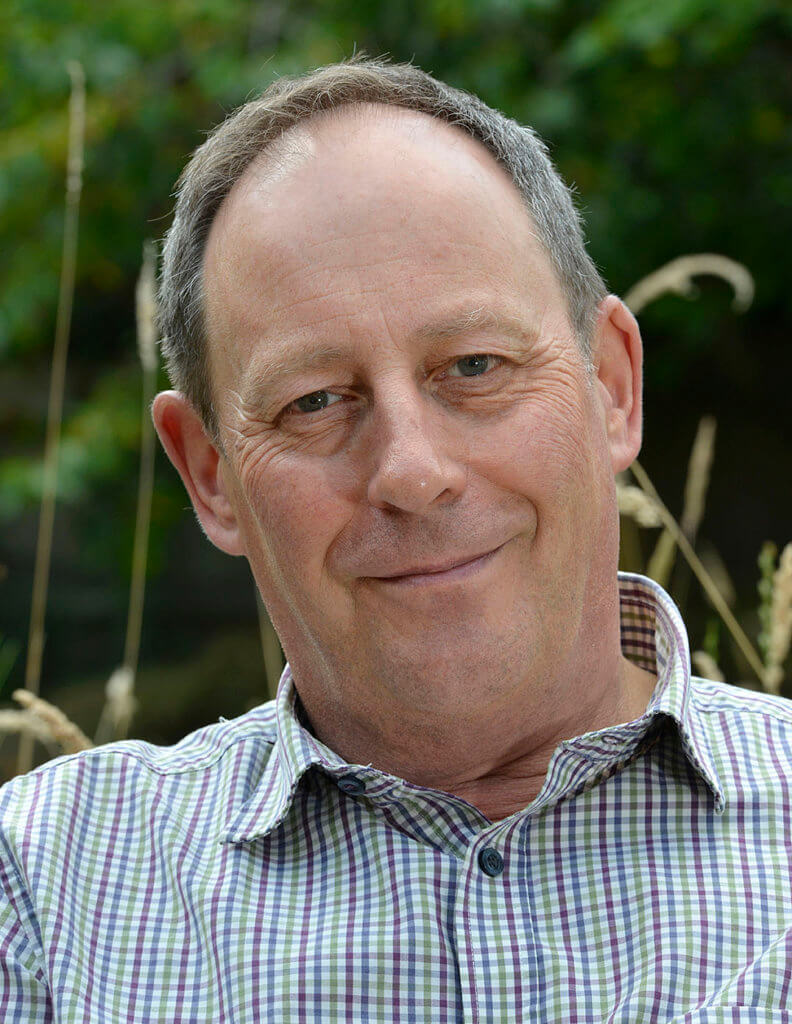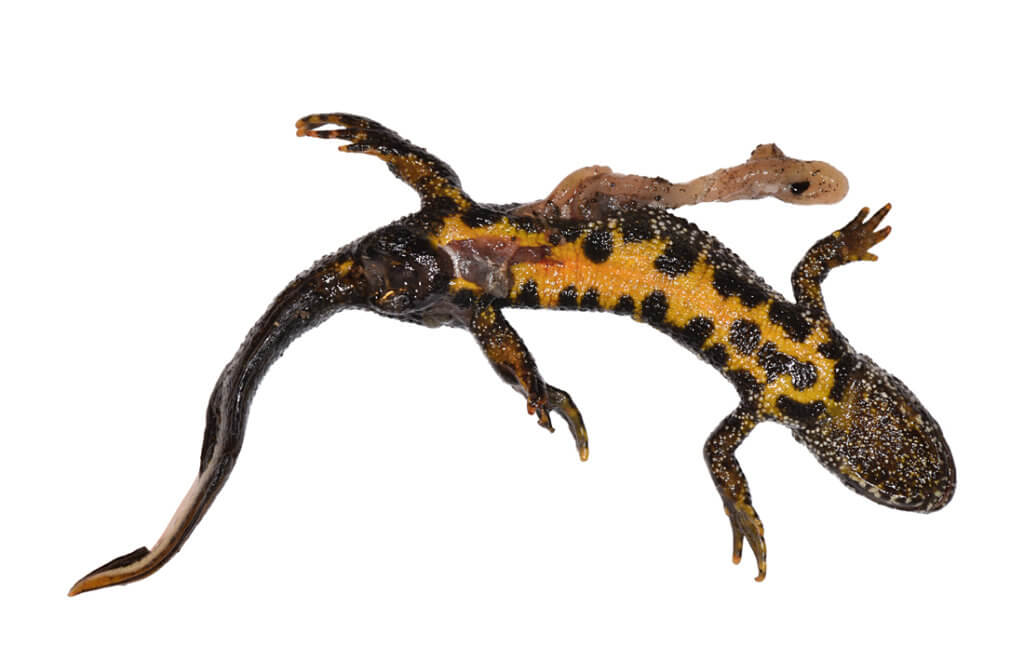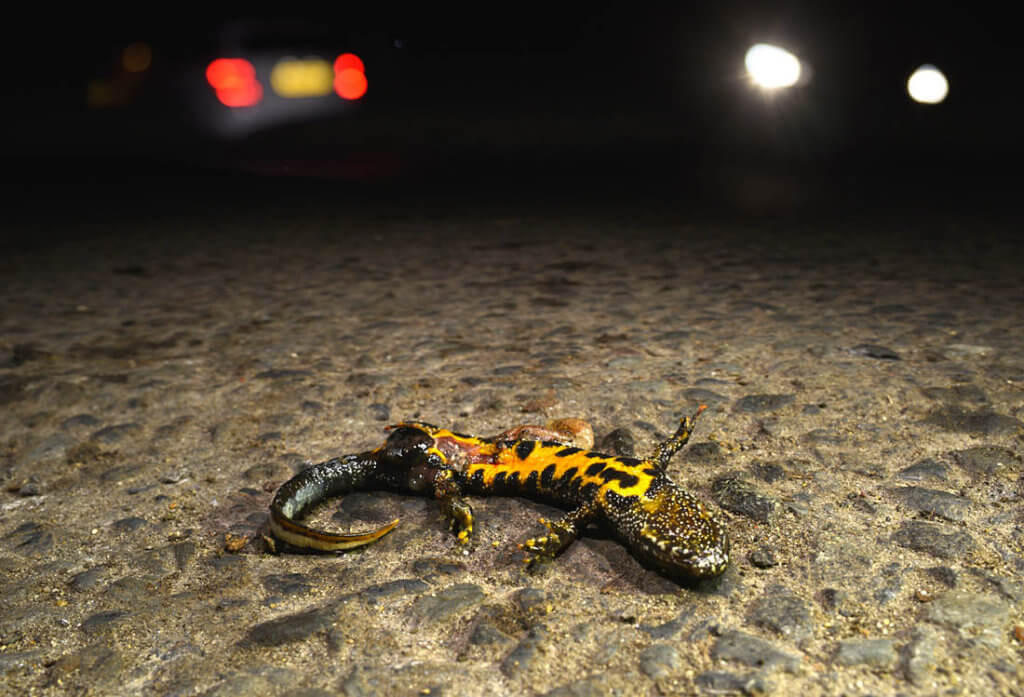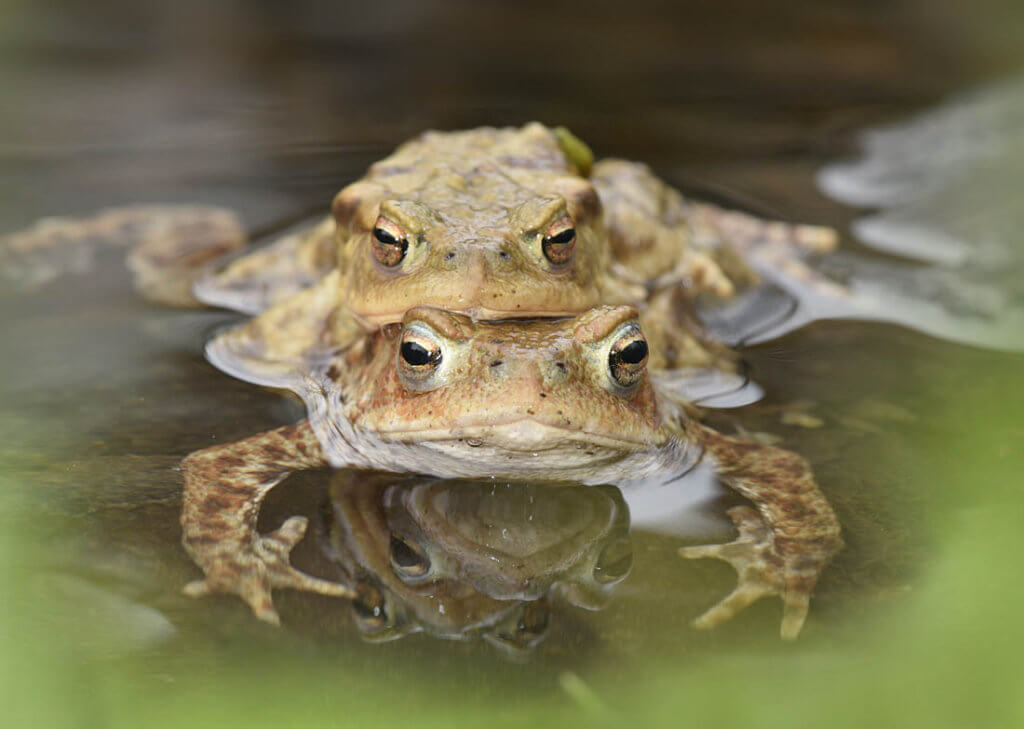
This blog by Dr Paul Sterry follows three earlier ones; Toad Rage, Toad Rage 2 and Toad Rage 3.
Paul Sterry has an academic background in freshwater biology and is a passionate conservationist. He has been writing about natural history and photographing wildlife for the last 40 years, with an emphasis on the British scene.
Toad Rage, and the curious case of Natural England.
The nights have drawn out and the clocks will soon spring forward, so the plan had been to start winding down the organised Toad Patrol season on Cufaude Lane. The hardcore have been out every night for the last month so perhaps the time had come to focus just on particularly wet and mild nights. The hope was that from now on any remaining migrating animals would be on the move long after the traffic had died down. So the animal welfare side of things could relax and the emphasis could switch more to conservation lobbying. That was the plan anyway.
We’ll come to that in a minute but first here are the figures for the season so far for Cufaude Lane’s familiar amphibians: Common Toads 736 saved, 184 squashed; Common Frogs 56 saved, 18 squashed; Smooth Newts 166 saved, 66 squashed. It is interesting to compare this with counts for the previous two years. Bear in mind that this season there have been between 4 and 11 volunteers on patrol each night. In 2017 and 2018 there were usually only three volunteers, there were nights when patrols did not take place, and on particularly challenging evenings all we could do was rescue animals, not count them. At that time we thought of it more as an animal welfare issue than a counting exercise. So numbers from those years are serious underestimates and only comprise some of the saved animals. 2017: Common Toads1,018; Common Frogs 357; Smooth Newts 203. 2018: Common Toads 976; Common Frogs 258; Smooth Newts 165.
So, the results are in, the votes have been counted, and the losers are…the amphibians, of course. Whatever way you look at it the trend in numbers is a downward one, with the decline in Common Frogs being particularly stark. But don’t worry councillors and developers-in-waiting: if enough time goes by then the problem will simply go away and Cufaude Lane’s amphibians will be driven to extinction, literally and figuratively. As for the poor toads, frogs and newts, things couldn’t get any worse. Or could they? Thanks to the wonders of aerial imagery, it now looks like a couple of ponds on private land that were important for spawning historically were drained a year or so ago. A cynic might see this as a pre-emptive move with future development in mind. But whatever the motive, five years down the line the adult toads that were faithful to those natal ponds will be dead through natural or traffic-related causes, having produced no offspring as a legacy. After that nobody will have to worry about amphibians again, or those pitiable toad-huggers.
Throughout this saga, developers, councillors and environmental consultants alike have been keen to change the subject when the topic of Great Crested Newts (GCN) is raised. If they engage at all it is usually on the subject of Common Toads. I must stop calling them common, because the name is hardly appropriate these days. Anyway, perhaps this amphibian bias might have something to do with the fact that toads have no real legal protection whereas GCNs do, of sorts. Now we come to the interesting bit. One particular event last Thursday was poignantly depressing for the toad-patrollers but by rights should be a conscience-pricking awakening for GCN-sceptics. Denial is no longer possible because one of the patrollers picked up a Great Crested squashed on Cufaude Lane by a passing car; it was a small male and by the looks of it one of last year’s youngsters. So, as naturalists with a long memory could have told them, GCNs do have established populations all along Cufaude Lane. At the time the corpse drew a small crowd of horrified onlookers. Later, when I examined the body more closely its tail began to twitch. Involuntary movement of course – the animal was flattened and its entrails were extruding after all. But there was a sort of last-gasp symbolism about the wretched creature’s writhing.

Thursday night’s illustrious casualty: Great Crested Newts may have nominal protection in law, but that’s no safeguard against the wheels of a car. Photo: Paul Sterry
I have an all-round interest in natural history but amphibians seem to have taken over my life recently. Must be something to do with all those squashed toads I have picked up. Now the toad migration season is winding down my thoughts were already beginning to turn to what else I could do to help these beleaguered animals. And even before last Thursday’s tragedy Great Crested Newts were on my radar. 60 years of natural history experience and local knowledge mean I know where most of my local GCN ponds are, and I know that some of them are not recorded on county and national databases. I can recognise a newt in the field without interfering with it and can spot GCN’s distinctive eggs at a dozen paces. That’s where I can make a difference I thought: with development looming in the area I could help by filling in gaps in the records, and identifying new sites. At least there might a chance of obliging developers to undertake GCN surveys. Not that I have any faith in the implementation or outcomes of GCN legislation but it had to be better than doing nothing. Or so I thought.
As a first port of call I contacted Natural England for advice. You would, wouldn’t you? But phone their Licensing Department and you enter a strange, Kafkaesque world where nothing quite makes sense, at least to this mere naturalist. As dispiriting experiences go I’d rank it somewhere between listening to a Brexit debate and booking a pre-paid Funeral. It turns out helping newts is not so simple after all, and you need a licence to observe them after dark; that’s the best time to spot them of course, with the aid of a torch. I must admit to being slightly baffled but I think the logic goes as follows: as an unlicensed individual, if you see a GCN by chance using a torch that’s tolerated but you can’t submit the record; if you switch the torch off and on again to double-check, or pay a return visit, then that’s a crime; shine a torch at a Great Crested Newt you know is there and you’re a criminal. It’s all about intent apparently.
Buy me a pint and I will bore you with the details but the short version is I applied for a GCN licence but Natural England was unimpressed and my application was turned down. I failed to meet a number of their criteria. An academic background in freshwater ecology and a lifetime spent studying, surveying and writing about British amphibians and other wildlife. Surely that would mean something to Natural England? No, silly me. And I failed on the reference front too: a former colleague of mine, Professor Trevor Beebee, vouched for my credentials. But apparently Trevor (or Mr Beebee as NE likes to call him) is not qualified enough, despite being co-author of Collins New Naturalist Amphibians and Reptiles, having a lifetime of herpetological experience under his belt, and being (as far as I am concerned) the Godfather of British herpetology. No doubt Natural England knows best but it feels more like a victory for bureaucracy than a step forward for conservation. And it has prompted me to wonder if the letter of the law, and its interpretation and subsequent amendments, reflect the spirit in which the legislation was conceived; and whether vested interests might have had an influence?
Call me a criminal but I will always help a Great Crested cross a road if I see one. But if I ever want to see one again in its natural habitat legally it looks like I will have to attend a course next year to be trained in the art of using a torch. There’s more to it than that of course, with netting and bottling also on the curriculum, not that I’d want to use those techniques. All sounds a bit ‘urban dictionary’ to me, but then again I have been out toading every night for the last month. Anyway, unless or until I get a Licence, I will be breaking the law if I knowingly look at a Great Crested again. That seems to be the message. But if I were to take such an unwise course of action I suspect I would not be alone, judging by the nervous glances and awkward silences you get when the subject is raised in amphibian-loving circles. There’s probably a darkweb community out there somewhere, whose members discuss their sick fantasy: the urge to shine torches into ponds in the dead of night. A sort of Urodelean (if such a word exists) love that dares not speak its name. I’d like to say it’s a funny old world, but the Natural England licensing process is entirely devoid of humour.

Probably the only way most ordinary mortals can see a Great Crested Newt legally is by spotting roadkill. This was the Cufaude Lane individual. Photo: Paul Sterry
Before this saga began I would never have dreamt it could be so difficult to help a Schedule 1 species. Naively perhaps I had assumed the legislation was there to protect the newts and their habitats from bulldozers rather than the admiring gaze of concerned naturalists. You want to watch a Great Crested Newt just for the pleasure of it? No chance. But with the aid of a compliant environmental consultant a canny developer can get up to all sorts of tricks, all entirely legal. You want to relocate Great Cresteds so you can build on their home? Hell, yes. Who cares that their new home may already have occupants, or that other unprotected amphibian species just have to take their chances. The Common Frogs and Smooth Newts affected might see this as a Licence to kill.
As a relative newcomer to the legal side to amphibian conservation, what strikes me is the emphasis that is placed on water. Sure, they need to spawn in ponds but adult amphibians, even Great Crested Newts in the main, are essentially terrestrial creatures that return to water just for a brief period each year to breed. Even while in water Great Cresteds need air, hence the need for training in the use of bottle-trapping; this rather distasteful technique, much-loved by GCN surveyors, results in trapped newts drowning if poor deployment denies them access to air. But I guess if the legislation really protected the poor amphibians’ terrestrial habitats that would be far too inconvenient for progress. What with all those house-building targets to meet.
Taking a step back, does Natural England really think this sort of approach – specifically the interpretation of the legislation – acts as an incentive for people to engage with conservation organisations and submit data? GCN licensing may be great for those environmental consultants who thrive on the benefits – a Licence to print money, some might say. But in practice it acts as a deterrent to amateur naturalists, not to mention nervous landowners, and I struggle to see how it operates in the best interests of GCNs, let alone other amphibians, in its current form. In the meantime who knows how many Great Cresteds have been killed as a result of under-recording or the intentional omission of records? Sadly, replace the words ‘Great Crested Newt’ with ‘Hazel Dormouse’ and almost the same story repeats itself in terms of legislative and conservation outcome.
I grew up and cut my natural history teeth in a time before most modern wildlife legislation even existed. A time when kids could jam jar a newt without fear of a spell in borstal. In the ensuing 50 years I have seen the steady degradation and destruction of wildlife-rich habitats around me, so I appreciate the need for legislative protection for vulnerable species. The trouble is I struggle to convince myself that the legislation actually achieves its goal and that its enforcers always prioritise wildlife over expediency.
Natural England-bashing is becoming a popular bloodsport and it’s easy to see why; my gripes about amphibians are trivial compared to some of their other causes célèbres. But if even seasoned naturalists and ardent conservationists are giving up on them, you have to wonder what the future holds for nature conservation. It’s not their fault, some might say. They’re woefully underfunded and only doing their jobs – you should blame the Secretary of State for Environment, Food and Rural Affairs, whoever that happens to be at the time. But who better than the NE hierarchy to influence Government policy and direct interpretation of existing laws for the full benefit of wildlife? Sadly the sceptic in me thinks that even resistance from within would be futile. I remember the 1980s when Nicholas Ridley MP was the incumbent Secretary of State; you may recall that when the Nature Conservancy Council (for younger readers, that’s a previous incarnation of Natural England) stood up for nature it didn’t end well. But given the era in which we live, maybe things are not so bad: somebody in Government is sure to come up with the bright idea of privatising or involving PFI in Natural England, at least in divisions like its licensing department. Perhaps Seaborne or G4S might be interested in tendering? Or better still, they could get rid of species protection altogether – it must be such a drain on resources.
It’s certainly true that Natural England’s budget has been slashed and its allowance is a reflection of the importance politicians of any hue place on wildlife and the environment. How NE operates internally is another matter. But gripes with the way they interpret and implement wildlife policy aside, you have to recognise that they answer to their political lords and masters. So, strange though it may seem to anyone who knows me, I find myself saying I don’t just blame the likes of Natural England, I blame everyone including myself. Politicians can be responsive creatures but only if they are aware of the strength of public feeling. So don’t just sit there reading this. Get angry, get vocal and above all do something. Do anything, to help wildlife.

At least some toads made it to their breeding pond. The Toad Team wishes this particular happy couple a long and car-free life. Photo: Paul Sterry
In the meantime the Cufaude Lane Gang will re-double its efforts, extend its remit and patrol the stretch of road adjacent to Upper Cufaude Farm, land that Hampshire County Council wants to sell for housing. We don’t expect any support from Natural England: it’s not their job after all. But for our part we want to be thorough and conscientious, and make sure we haven’t missed anything. Like more Great Crested Newts, for example. And of course the team will continue to rage against the machine on the toads’ behalf.
[registration_form]
The juxtaposition of this blog with those on the general licence highlights what a topsy turvy world we now live in. A highly experienced and competent naturalist cannot obtain a licence to to do something that would only be beneficial to the newts whilst any fool who feels like peppering a few crows with lead shot has his licence already there for him and, in the unlikely event he is challenged, all he needs to do is pretend he is suffering intolerable damage from said crows.
My thoughts exactly!
Bless you Sir, you are a star, an inspiration. You illustrate in microcosm the real world of conservation amid the pseudo beaurocratic version which we see to often now.
NE not fit for purpose yet again. Process over outcome yet again.
Let’s give Tony Juniper a year to turn things around, but if there’s still no change after that maybe we conservationists should ourselves campaign to abolish NE if only to show everyone just how bloody worse than useless it is.
Just a thought, maybe not a good idea, but the mere fact I thought it doesn’t say much for NE.
As an advisory body and the CS / HLS scheme advisers, by all means review and reform – long overdue. Be careful what you wish for I can hear some say (as they hit the dislike button) but there are so many case studies available of their ‘dog’s breakfast’ dealings that they are not really fit for purpose any longer. Ever an agnostic, Tony work your magic …. but yes, a time-frame and then we review their performance?
The only issue I’d have is what do we do with NNRs. No-one was interested when they were offered a few years back now, principally because of the staff pension liabilities as I understood the issue.
They are public land and I’m not sure what the answer is around ensuring they are properly managed if we abolish NE.
Is the agency fit for purpose? Muzzled Watchdog (1997) to toothless terrier to lapdog? I suppose sadly we are witnessing the continued morphing to developers moll?
This case study is surely one the incoming Chairman might look at, it’s surely a relatively easy thing to wrestle with?
I remember a friend upset that she’d inadvertently strimmed a GCN when tidying up around an old barn, the GCN had tucked itself away in the gap left by missing mortar. Try as I might to save it, it died. So, not one to waste such specimens I pickled it and donated it to the local Museum – what a performance! Like Dr Sterry I too was made to feel like a criminal. In the meantime criminals are aided and abetted it seems ….
Well done Paul – a great passionate series of blogs. I am encountering a similar problem with bats. Where I live (not far from you) there has been a proliferation of bat boxes as prescribed by the environmental consultants. Some of these boxes appear to be less than optimally located. Once the box is up no-one can move it without the relevant license. Getting the relevant license is a prohibitively time-consuming and expensive process. Of course, someone could pay the consultant to come back and move the box …
Rather like Paul I have been a naturalist all my life and can remember heady days at various ponds as a youngster catching newts. Some of those ponds are still there the majority are not and yes they or most contained big black newts GCN to the legislators, indeed I can recall some ponds where they were the only newt.
I am these days primarily known as a birder and have been ringing birds with of course the appropriate licences for 46 years and visiting schedule one nests for about 35 years with again licences. Yet I have never had a GCN licence, never applied for one and can remember a group of us about 30 years ago rescuing some ( rather a lot) of newts from a garage demolition site where we by chance found them exposed and yes this included GCN. they were moved to a local nature reserve with appropriate ponds. I suspect if I were to apply for a licence I would be like Paul refused. Yes I still look at newts with a torch occasionally and will no doubt continue to do so! The NE interpretation of the law on this is an ass!
Like Mr Irving, I too have held Schedule one’s for over thirty years,for which I am very grateful, so I
should be careful what I say.
However, what you describe,especially the disregard shown to your referees, is twattishness of the
highest order.
I suggest you carry on, doing what you think is in the best interest of the animals, should a case come
to court I think you would get more than enough support to cover your legal fees, and you would win.